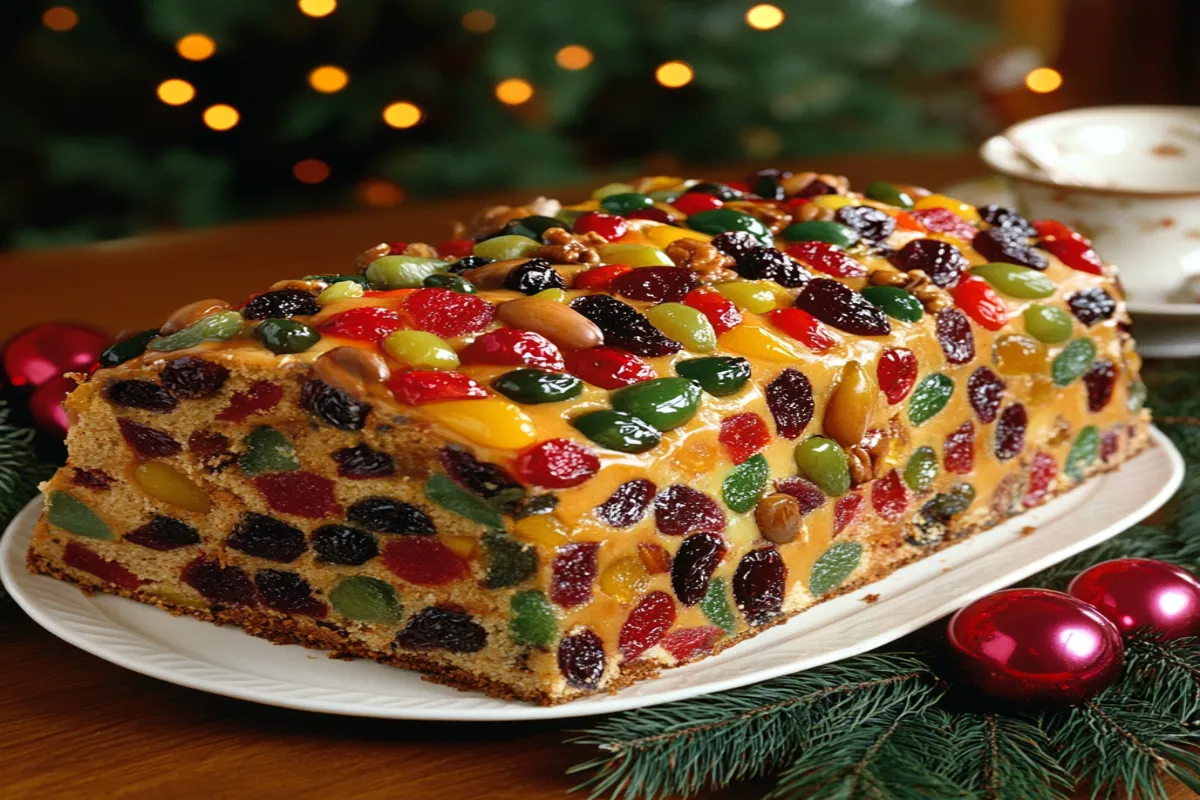Fruitcake, a dense dessert filled with candied fruits, nuts, and sometimes alcohol, has a long and complex history. At one point, authorities in parts of Europe outlawed it—a surprising fact for many. But why was fruitcake outlawed? This article explores the history of fruitcake, the reasons behind its temporary ban, its rise and fall in popularity, and its continued presence in holiday traditions worldwide. We’ll also debunk common myths about fruitcake and discuss its modern revival.
The Ancient Origins of Fruitcake: From Roman Times to the Middle Ages
Understanding why fruitcake was outlawed requires looking back at its origins. The earliest versions of fruitcake date back thousands of years to the Roman Empire. Roman soldiers relied on a mixture of barley, dried fruits, seeds, and honey for sustenance during long campaigns. This early form of fruitcake served as an ancient energy bar that provided nourishment for extended journeys.
As the Roman Empire expanded, the popularity of fruitcake spread throughout Europe. By the Middle Ages, people had refined the recipe, creating a recognizable form of fruitcake. They preserved fruits with sugar to create dried fruits like raisins and currants. They combined these preserved fruits with nuts, honey, and spices, forming a flavorful, calorie-dense cake that could last for months. Travelers and soldiers valued fruitcake for its long shelf life and its ability to sustain them during journeys.
During the medieval period, people also enjoyed fruitcake during festive celebrations, especially in the winter months when fresh fruits weren’t available. The preserved fruits allowed them to savor sweetness during colder months, and fruitcake became closely associated with religious festivals and holidays.
For more on how sugar influenced the evolution of fruitcake and other culinary traditions, check out this article.
Why Did Authorities Ban Fruitcake in the 18th Century?
So, why was fruitcake outlawed? By the 18th century, fruitcake had become a symbol of indulgence, especially in Europe. The lavish ingredients—candied fruits, nuts, spices, and alcohol—gave fruitcake its luxurious reputation. However, religious leaders viewed fruitcake’s richness as a sign of gluttony and excess. They claimed that this dessert encouraged overindulgence, which conflicted with their values of restraint and moderation.
These leaders labeled fruitcake as immoral and sinful. They urged local authorities to impose a ban in certain regions. They argued that consuming such an extravagant dessert was inappropriate, particularly during times of austerity. As a result, some European regions decided to outlaw fruitcake. However, society’s attitudes toward food and indulgence eventually shifted. As a result, authorities lifted the ban, and fruitcake returned to holiday traditions.
For a deeper look at the journey of fruitcake and why it was banned, check out this fruitcake guide.
The Rise and Fall of Fruitcake’s Popularity
After the ban ended, fruitcake regained its status as a holiday staple in the 19th century. However, the Industrial Revolution of the 20th century changed how fruitcake was made and consumed. Companies began mass-producing fruitcakes, making them widely available to the general public. Unfortunately, focusing on quantity over quality led to a decline in the cake’s overall appeal.
Manufacturers cut costs by using lower-quality ingredients, such as neon-colored candied fruits and artificial preservatives. These cheaper, mass-produced fruitcakes no longer resembled the rich, handcrafted cakes of the past. People began associating fruitcake with poor quality and unwanted holiday gifts.
In the United States, fruitcake became a running joke. People viewed it as an obligatory holiday gift that no one actually wanted. Late-night host Johnny Carson famously joked, “There is only one fruitcake in the entire world, and people keep sending it to each other.” This humor cemented fruitcake’s reputation as a holiday punchline rather than a beloved treat.
Modern Myths: Was Fruitcake Really Outlawed?
The question, “Why was fruitcake outlawed?” has persisted, leading to modern myths and urban legends. One enduring myth suggests that fruitcake remains outlawed today. This misconception likely stems from its brief ban in parts of Europe during the 18th century. While religious authorities did ban fruitcake for a time, no modern laws prohibit its consumption. The ban ended long ago, but fruitcake’s controversial status has lingered.
A Canadian satirical radio interview revived the myth. During the interview, a fictional representative from the “Ministry of Seasonal Desserts” humorously claimed that fruitcake had been made illegal due to its “extreme unpopularity.” While this was meant as a joke, it sparked new interest in fruitcake’s complicated history and its temporary ban.
Despite these myths, fruitcake remains legal and widely available. However, people continue to have mixed opinions about it—some see it as a nostalgic holiday treat, while others avoid it.
Global Variations: How Different Cultures Celebrate Fruitcake
Although fruitcake lost popularity in some places, it continues to hold an important place in holiday traditions around the world. Various cultures have created their own unique versions of fruitcake, often incorporating local ingredients to suit regional tastes. Let’s explore some of the most notable fruitcake traditions:
- Germany: In Germany, stollen serves as the country’s version of fruitcake. This fruit-filled bread is lighter than the dense cakes in the U.S. and is dusted with powdered sugar. People often add spices like cinnamon and nutmeg to enhance its flavor.
- Italy: Italy’s fruitcake, panettone, is a tall, airy cake filled with dried fruits. Panettone remains a popular Christmas dessert, and its light texture sets it apart from heavier fruitcakes.
- India: In India, Allahabadi cake is the fruitcake of choice during Christmas. This cake includes dried fruits, spices, and rum or brandy, reflecting a blend of Indian and British culinary traditions.
- Hawaii: Hawaiian fruitcake uses tropical ingredients like pineapple and macadamia nuts. These flavors give the traditional cake a refreshing and unique taste.
These global variations show that fruitcake, while not as popular in some places, remains a cherished part of holiday traditions in many cultures.
The Modern Revival of Fruitcake

Despite the poor reputation that mass-produced fruitcakes earned in the 20th century, the dessert has experienced a revival in recent years. Artisanal bakers and chefs have returned to traditional recipes, using high-quality ingredients to craft fruitcakes that rival the luxurious versions of the past.
Modern fruitcakes often include organic dried fruits, premium nuts, and small-batch liquors like rum or brandy. These handcrafted cakes offer rich flavors and textures that remind people of the original fruitcakes enjoyed centuries ago. As more people seek out high-quality, handmade foods, fruitcake is finding its way back into holiday celebrations.
In addition to traditional recipes, some bakers have added creative twists to fruitcake. Modern versions may include chocolate, citrus zest, or exotic spices to appeal to contemporary tastes. Others have developed gluten-free or vegan versions to accommodate dietary needs, making the dessert more accessible to a broader audience.
If you’re interested in making your own fruitcake, you can explore these fruitcake recipes for inspiration.
FAQs About Fruitcake
Was fruitcake really banned?
Yes, in parts of Europe, religious authorities banned fruitcake during the 18th century. They viewed it as a symbol of indulgence and gluttony. However, they eventually lifted the bans over time.
Why do people dislike fruitcake?
Many people dislike fruitcake because of experiences with mass-produced versions. These cakes often use neon-colored candied fruits and preservatives, resulting in an artificial taste that gives fruitcake a poor reputation.
Is fruitcake still popular in other countries?
Yes, Germany, Italy, and India still celebrate with their own versions of fruitcake. In Germany, stollen is a Christmas staple, and in Italy, panettone is enjoyed during the holidays.
What are the key ingredients in fruitcake?
Fruitcake typically contains dried or candied fruits, nuts, spices, and sometimes alcohol like rum or brandy. These ingredients give the cake its rich flavor and help preserve it.
Conclusion: Why Was Fruitcake Outlawed, and What’s Its Future?
So, why was fruitcake outlawed? Religious authorities once viewed it as a symbol of indulgence, leading to its brief ban in parts of Europe during the 18th century. Today, fruitcake has moved past that period of controversy and remains a unique part of holiday traditions around the world. From its ancient origins to its modern revival, fruitcake continues to represent celebration, abundance, and nostalgia for many.
As food trends shift, fruitcake may continue to gain popularity. With a renewed focus on quality ingredients and craftsmanship, this controversial dessert could once again become a beloved holiday treat. Whether you love or dislike it, fruitcake’s long history and cultural significance make it an important part of the holiday season.
Next time someone offers you a slice of fruitcake, give it a chance—you might discover it has more to offer than you expected.

